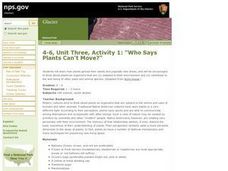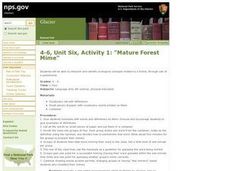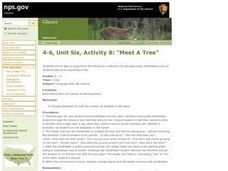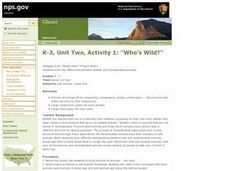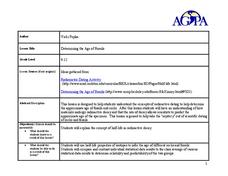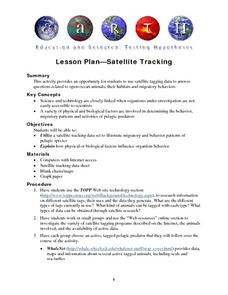Curated OER
Animal Characteristics
Students investigate the characteristics of animals by creating a chart. In this animal life lesson, students create a KWL chart listing all the different animals a class can name. Students take a field trip to a science facility to get...
Curated OER
Characteristics of Materials
Students examine everyday materials by utilizing educational software. In this group analysis instructional activity, students identify several different fabrics and materials used in everyday life. Students participate in a computer...
Curated OER
Galapagos Adaptations
Young scholars examine photographs of closely related species found in the Gal??pagos environment, observe differences and similarities between species, and form hypotheses about species differences and the relationship to the...
Curated OER
Some Like it Cold: Canada's Northern Communities
Fifth graders examine cultures close to the arctic circle. In this geography lesson, 5th graders consider the impact of climate on cultural development of arctic communities. Students research a given community and present their findings...
Curated OER
Up the Down Tree House
Students investigate the decomposition process. In this ecology lesson, students participate in a play, "Up the Treehouse" where the main idea focuses on a decomposing tree and how food chains are effected by decomposition. After the...
Curated OER
Garbage in the Garden
Students create their own compost. In this soil lesson, students fill a bag with waste and soil, in order to create a mini compost bin. Students observe the baggies over a 6 week period, they record their findings and collect data...
Curated OER
My Favorite Animal
Students research an animal of choice and create a project. In this animal science instructional activity, students choose an animal living in the International Peace Park to research. Students write a paper and create a...
Curated OER
Carbon Cycle Capers
Students examine the carbon dioxide cycle in the atmosphere. In this element lesson, students discuss the relationship between carbon dioxide on Earth and the plants that store it. Students play a game to ensure their understanding.
Curated OER
Who Says Plants Can't Move?
Students discover how plants spread their seeds using other plants and animals. In this plant lesson, students role play different plants and how their seeds travel. Students then have a class discussion to ensure their understanding.
Curated OER
Forest Communities
Students identify tree specimens. For this tree specimens lesson, students collect different parts of a tree from the areas around the school or their home. They then work in groups to create booklet that identifies tree...
Curated OER
Tracks along the Trail
Young scholars identify animal tracks outdoors. In this animal life activity, students go outdoors and find several different animal tracks to identify. Young scholars also discuss how animals must adapt in the winter months.
Curated OER
Mature Forest Mime
Students come to understand vocabulary words through pantomime. For this vocabulary lesson, students first review several vocabulary words and their meaning, then they work in groups to pantomime the definitions.
Curated OER
Meet A Tree
Students explore different types of trees with their senses. In this nature lesson plan, students play a game in which pairs use their senses to explore trees, blindfolded. Students then must find the tree they found when blindfolded.
Curated OER
Who's Wild?
Students explore the differences between animals of the wild and domesticated animals. In this wild animals lesson, students understand that tame animals ancestors were once wild. Students illustrate the differences by...
Curated OER
Hero Or Zero?
Students investigate science and technology by reading a children's book. In this reading comprehension lesson, students read the story Archibald Frisby and discuss the ways we use science and technology in everyday life....
Curated OER
Basic Orienteering
Students study orienteering. In this science lesson, students study the parts of a compass and use the compass to set a bearing and follow the bearing on the compass.
Curated OER
Animal Tracks
Students study animals. In this science lesson plan, students make plaster casts of animals that live in the area. Students identify the tracks.
Curated OER
Ocean Careers Exploration
Learners will work together in groups to gather information about careers in oceanography. They discover the need to have a diverse group of people on a team and then share their information with the class. Web links and materials are...
Curated OER
Biomes
Arranged as an interactive lesson, this presentation focuses on the six world biomes. Upcoming biologists click on a specific biome and a slide lists its location, description, native plants, and animals. A quiz provides learners with...
Exploratorium
Persistence of Vision
Ahoy, matey! Peer through a special telescope to explore the persistence of vision. The telescope has only a thin strip with which to view the world, but as it scans the area, your eye and brain work together to create a complete...
Population Connection
Where Do We Grow from Here?
Did you know that the population is expected to grow to 11 billion by 2100? The resource serves final installment in a six-part series on the global population and its effects. Scholars interpret data from the United Nations about the...
Alabama Learning Exchange
Action at Plate Boundaries
Pupils diagram the spreading of the ocean floor. In this earth science lesson plan, students read an article on plate boundaries of the ocean. Pupils are expected to diagram the oceanic convergent boundary, and give a...
Curated OER
Determining the Age of Fossils
High schoolers examine the concept of radioactive dating. In this radioactive dating lesson, students investigate how to determine the ages of fossils and rocks as they learn about half-life radioactive decay.
Curated OER
Satellite Tracking
Students apply satellite tagging data to investigate questions related to open-ocean animals, their habitats, and their migratory behaviors. They determine how physical or biological factors determine organism behavior using a data...








